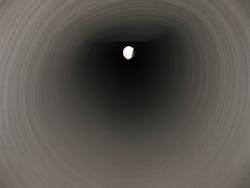Smuggler’s Notch ski resort, near Jeffersonville, VT, was established in 1956 and is New England’s fourth-largest resort area. It is built around Morse, Madonna, and Sterling mountains. Record storms in the Northeast, and the resulting record snowmelt, caused near-flooding at Smuggler’s Notch, and two 72-inch “boilerplate” culverts, each 130 feet long, were filled to near capacity with fast-moving water. They survived but were damaged; it was clear to managers that the culverts needed major rehabilitation before the next spring thaw.
“These culverts serve about six-tenths of a square mile of the Sterling and Madonna drainage areas,” says Smuggler’s Notch vice president Mark Delaney, “and they pass under the road that provides access to the main lodge–excavation wasn’t really an option.” Smuggler’s Notch is a three-season resort, and even in the offseason the road is heavily used during snowmaking operations. So the rehabilitation solution had to keep the road open. This ruled out excavation and replacement, which also would have been the most expensive option.
Both culverts were worn at the invert, with some pinholing and actual cracks. The higher of the two pipes had a short section that had collapsed during the near-flooding, the lower culvert displayed some sidewall deterioration, and there was rust and serious wear in both.
Sliplining was a possibility, but it wasn’t the optimum solution for two reasons. “To make sliplining work, we would have to use pipe that seriously reduced the inside diameter of the culverts,” says Dave Arruda, co-owner of Arruda Trenchless Construction, “and they really needed all the capacity they could get. Also, the staging area required for sliplining would have destroyed an important headwall.”
There was one more critical factor to consider in the scheduling: work on the culvert would ideally take place in a two- to three-week window at the end of October and the beginning of November when water flow was relatively low. A project that lasted longer than that would require elaborate water diversion, which could have shut down the road.
So Smuggler’s Notch needed a trenchless rehabilitation solution that was structural, waterproof, and fast and that wouldn’t significantly reduce interior diameter. Ideally, it would also be cost effective compared to other methods. Fortunately, while reading a trade journal, Delaney saw an ad for Centri-Pipe, a centrifugally cast concrete pipe (CCCP) solution that is emerging as a best practice for large-diameter pipe in need of structural repair and waterproofing. It’s a technology created and refined by AP/M Permaform for use in manholes, and is now being used in horizontal pipe.
Centri-Pipe uses a precisely controlled spincaster that is inserted into horizontal pipe and then withdrawn; runs of more than 400 feet are possible. As the spincaster is withdrawn, it applies thin, precisely engineered layers of high-strength grouts that seal existing sewers and adhere tightly to the existing substrate, which can be any round or elliptical pipe including CMP, concrete, clay, brick, and other materials. The Smuggler’s Notch culverts were somewhat unusual. “These are riveted steel pipes that were installed in the 1960s,” says Arruda. “But they actually date to the 1930s and were originally used as smokestacks!”
Prep work for CCCP is basic. The collapsed section was repaired and shored up, and grout was injected into pipe sections where the failed invert had led to washed-out bedding. Before spincasting took place, the newly repaired section was “roughed up” a bit to guarantee good adherence. PL-12,000, a self-consolidating mortar from AP/M Permaform, was used to patch the invert and provide a smooth rolling surface for the Centri-Pipe spincaster. If pipe is dirty or crumbling due to corrosion, it can be cleaned with Centri-Pipe’s high-pressure spin washer. The staging area was minimal; typical CCCP projects require just enough room to park a 20-foot box truck and 25-foot trailer.
Arruda dewatered the pipes individually by building an upstream weir, passing water through a 10-inch PVC pipe, and diverting flow to whichever culvert was not being actively repaired.
Centri-Pipe is an engineered solution, with designers at AP/M Permaform calculating the thickness of the final product, specifying the number of passes used to apply that thickness, and selecting the material to be applied. In this case, four Centri-Pipe passes (per pipe) were used to apply a total thickness of 1.5 inches of AP/M Permaform’s PL-8000. PL-8000 is a cementitious, fiber-reinforced mortar with excellent properties for CCCP: it is rust- and corrosion-resistant, has high strength, and cures quickly.
After seven days onsite (less than would be required for sliplining) the end result was a smooth, watertight, rustproof, structurally sound rehabilitation with no road closures and no damage to headwalls. Because PL-8000 cures quickly, the culverts could be returned to service immediately. Smuggler’s Notch served as its own general contractor for the work and inspected operations daily to ensure quality.
Delaney says that Centri-Pipe was actually the least expensive solution considered. “We had estimates on excavation, sliplining, and Centri-Pipe–excavation easily cost the most, of course, but sliplining was just a little more than Centri-Pipe. But it wasn’t really a contest; in this circumstance, Centri-Pipe was clearly the most expedient and practical way of getting this job done, and we are very happy with the results.”
Arruda adds, “This is one of the largest projects we’ve done as a company, and it went without a hitch. We had very good support from Smuggler’s Notch and AP/M Permaform, and I look forward to taking on even bigger projects with Centri-Pipe.”
Tom Watson Jr., the second president of IBM, was an important early figure in the development of Smuggler’s Notch, and the resort has been one of the most progressive in New England in terms of ski lift and snowmaking technology. So it’s fitting that even humble infrastructure maintenance is addressed with cutting-edge solutions. This was a big win for Smuggler’s Notch; by using a relatively new technology, the resort was able to quickly and completely rehabilitate important infrastructure without road closures, and also save money.







